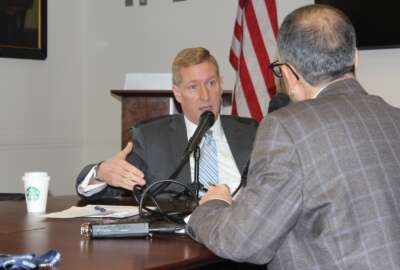
More immigration judges, consolidation color DOJ 2020 budget request
Despite a proposed nearly $700 million budget decrease and several consolidations, the Justice Department wants more FTEs in fiscal 2020.
Despite a proposed nearly $700 million budget decrease and several program consolidations, the Justice Department wants to fund about 2,500 more FTEs in fiscal 2020. Areas such as immigration and border security would see major staff increases, while duties of the Bureau of Alcohol, Tobacco, Firearms, and Explosives, and U.S. Marshals Service would shift.
The budget requests $29.2 billion for DOJ, a 2% decrease from the 2019 estimate. Attorney General William Barr spoke to House and Senate appropriations subcommittees on Tuesday and Wednesday, respectively, although most of the questions he faced in either chamber were to do with the Mueller Report.

“I’m proud of the department’s accomplishments and our workforce of more than 112,000 men and women and I’m looking forward to your support for the resources we need for their important work,” he said before the Senate Appropriations Subcommittee for Commerce, Justice, Science, and Related Agencies on Wednesday.
DOJ’s budget request also allocates $132 million for programs cyber, counterterrorism and counterintelligence. DEA specifically would receive $11.7 million for cyber investigation capabilities and to place technical specialists in each of its 23 field offices to assist on “cyber-specific cases.”
DOJ is eyeing an additional $70.5 million for the FBI’s cyber information-sharing abilities, and $2 million for the department’s data centers, which contain high-value assets and information.
Expansion and new hires
The Trump administration is requesting an additional $72.1 million for border security and immigration enforcement, with $71.1 million going to hire 100 new immigration judges and support staff for the Executive Office for Immigration Review. That would bring the number to 634 — a 31% increase from fiscal 2018 — by the end of FY 2020.
“At the end of the first quarter of FY 2019, there were over 820,000 cases pending in immigration courts nationwide,” Barr said in his written testimony. “That caseload is by far the largest-ever pending caseload before the department, marking the 12th consecutive year of increased backlogs.”
The budget includes $6 million for the Southwest Border Rural Law Enforcement Violent Crime Reduction Initiative, a new grant program in the Office of Justice Programs. It would provide training, technical assistance and resources to stop drug and human traffickers. OJP would also take on the National Institute of Corrections from the Bureau of Prisons.
Related Stories

DOJ grants management program funds for crime reduction, victim services initiatives
It gives $137.9 million for programs to reduce crime and combat transnational criminal organizations, as well as for the Bureau of Alcohol, Tobacco, Firearms, and Explosives’ National Integrated Ballistic Information Network. Barr said this would allow ATF to expand the National Correlation and Tracing Center to five more sites, have additional training, increase ballistic imaging and correlation hardware and software, and expand services to NIBIN sites. This would bring the number of NIBIN sites to about 200 by the end of FY 2020.
Areas to be consolidated
Despite some expansions at ATF, under this proposal the “alcohol and tobacco enforcement” role of ATF would transfer to the Treasury Department’s Alcohol and Tobacco Tax and Trade Bureau. ATF would keep its firearms and explosive duties, but the agency would shrink by 33 FTEs, according to DOJ’s budget summary.
Last month ATF Deputy Director Thomas E. Brandon — who is retiring at the end of April — reportedly told the House Appropriations Committee he believed the budget request would force his agency to lose 377 positions. When pressed about this change by Sen. Patrick Leahy (D-Vt.) on Wednesday, Barr said that was not entirely the case but admitted he was not completely clear on ATF’s accounting methods.
“We don’t think he will lose those positions, there’s some complicated accounting here that I’m sort of a little mystified by myself, but as I understand it we’ve been continually investing and increasing the number of ATF agents and they were worried about bringing on too many agents in excess of funds that were going to be appropriated,” Barr said. “And they had sort of … the way they quickly make up for that is to just take out head count rather than make cuts across the board.”
In his written testimony, the attorney general said transferring alcohol and tobacco authorities will allow ATF to devote additional resources to its primary mission of combating violent crime through initiatives such as its highly effective NIBIN and Crime Gun Intelligence Centers.
The U.S. Marshals Service would also be used for more dignitary protection and gain 21 FTEs. This proposed $1 million move is part of the Protective Detail Consolidation evaluation, which is part of the White House’s government reorganization introduced last year, and which would “standardize executive branch official protection in agencies that currently have USMS security details or that have their own employees deputized by the USMS,” according to the Congressional Research Service.
In another attempt to give USMS more authority, President Donald Trump signed an executive order in July to let the agency directly hire certain deputy marshals and criminal investigators without using competitive service procedures.
Copyright © 2024 Federal News Network. All rights reserved. This website is not intended for users located within the European Economic Area.
Amelia Brust is a digital editor at Federal News Network.
Follow @abrustWFED




